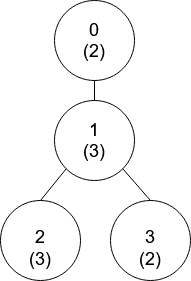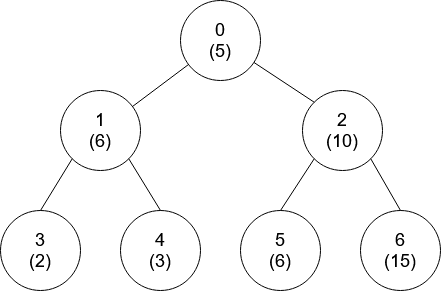Tree of Coprimes
There is a tree (i.e., a connected, undirected graph that has no cycles) consisting of n nodes numbered from 0 to n - 1 and exactly n - 1 edges. Each node has a value associated with it, and the root of the tree is node 0.
To represent this tree, you are given an integer array nums and a 2D array edges. Each nums[i] represents the ith node's value, and each edges[j] = [uj, vj] represents an edge between nodes uj and vj in the tree.
Two values x and y are coprime if gcd(x, y) == 1 where gcd(x, y) is the greatest common divisor of x and y.
An ancestor of a node i is any other node on the shortest path from node i to the root. A node is not considered an ancestor of itself.
Return an array ans of size n, where ans[i] is the closest ancestor to node i such that nums[i] and nums[ans[i]] are coprime, or -1 if there is no such ancestor.
Example 1:

Input: nums = [2,3,3,2], edges = [[0,1],[1,2],[1,3]] Output: [-1,0,0,1] Explanation: In the above figure, each node's value is in parentheses. - Node 0 has no coprime ancestors. - Node 1 has only one ancestor, node 0. Their values are coprime (gcd(2,3) == 1). - Node 2 has two ancestors, nodes 1 and 0. Node 1's value is not coprime (gcd(3,3) == 3), but node 0's value is (gcd(2,3) == 1), so node 0 is the closest valid ancestor. - Node 3 has two ancestors, nodes 1 and 0. It is coprime with node 1 (gcd(3,2) == 1), so node 1 is its closest valid ancestor.
Example 2:

Input: nums = [5,6,10,2,3,6,15], edges = [[0,1],[0,2],[1,3],[1,4],[2,5],[2,6]] Output: [-1,0,-1,0,0,0,-1]
Constraints:
- nums.length == n
- 1 <= nums[i] <= 50
- 1 <= n <= 105
- edges.length == n - 1
- edges[j].length == 2
- 0 <= uj, vj < n
- uj != vj
Solution:
traverse tree from root, keep track of a map of <val, <index, depth>>, in each level, iterate through all possible coprimes and try finding them in the map. update the map before and after next dfs call
class Solution {
public int[] getCoprimes(int[] nums, int[][] edges) {
Map<Integer, List<Integer>> graph = new HashMap();
for (int i = 0; i < nums.length; i ++) {
graph.put(i, new ArrayList());
}
for (int[] edge : edges) {
graph.get(edge[0]).add(edge[1]);
graph.get(edge[1]).add(edge[0]);
}
int[] res = new int[nums.length];
dfs(0, res, nums, graph, new HashMap(), new HashSet(), 0);
return res;
}
private void dfs(int index, int[] res, int[] nums, Map<Integer, List<Integer>> graph, Map<Integer,/*index, maxDepth*/ int[]> occur, Set<Integer> visited, int depth) {
visited.add(index);
int val = nums[index];
int ancestor = -1;
int maxDepth = -1;
for (int i = 1; i <= 50; i ++) {
if (occur.containsKey(i) && gcd(i, val) == 1 && occur.get(i)[1] > maxDepth) {
maxDepth = occur.get(i)[1];
ancestor = occur.get(i)[0];
}
}
res[index] = ancestor;
int[] exist = (occur.containsKey(val)) ? occur.get(val) : null;
occur.put(val, new int[]{index, depth});
for (int next : graph.get(index)) {
if (!visited.contains(next)) {
dfs(next, res, nums, graph, occur, visited, depth + 1);
}
}
if (exist != null) {
occur.put(val, exist);
} else {
occur.remove(val);
}
}
private int gcd(int x, int y) {
if (x < y) return gcd(y, x);
if (y == 0) return x;
return gcd(y, x % y);
}
}